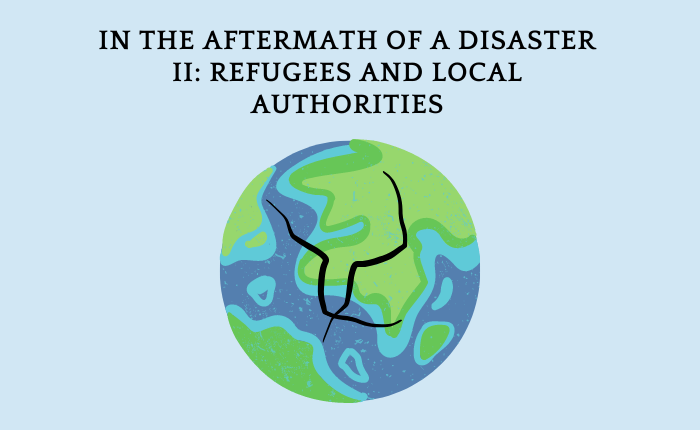By Ceren Kulkul, Post-doc Researcher at Migration Research Center at Koç University MiReKoc
In the previous blog post, we focused on the actors of the internal migration caused by the earthquake disaster and the picture that emerged in the immediate aftermath of the earthquake. We touched upon the efforts of many displaced individuals to survive in another city, often using their own resources (social capital), their efforts to establish a new life in these newly arrived cities, and their hopes of returning to their hometowns. In this article, as a sequel to this topic, we aim to make a brief analysis of asylum seekers and migrants living in the earthquake zone.
According to the official data of the Directorate of Migration Management, 1,738,035 Syrians are residing in the earthquake zone.[1] This region has the highest number of Syrian refugees under temporary protection status in Turkey. According to the United Nations High Commissioner for Refugees (UNHCR), there are more than 1.7 million migrants affected by the earthquake in the earthquake zone. 47.000 of these migrants are staying in temporary accommodation areas or tents. In the light of these figures, it would not be wrong to say that Syrian refugees are one of the most affected groups by the earthquake disaster. In the post-earthquake situation report prepared by Sert et al. (2023), it was criticised that the reports prepared by non-governmental organisations and bar associations in the region unmentioned Syrian refugees. (Sert et al, 2023, pp. 2). Yet, UNHCR Representative Philippe Leclerc declared that “From the regional perspective, obviously this is an absolute hammer blow for Syria’s displaced populations. The refugees and those who have been displaced within Syria itself are already suffering from an economic crisis.”[2]
Based on this statement, let’s brainstorm a few items on the challenges and difficulties that refugees might experience after a large scale disaster.
Vulnerability: Refugees are often people who are already living under difficult conditions and are vulnerable. In disasters such as earthquakes, refugees can often be at greater risk. They may have limited access to emergency information due to language barriers, cultural differences, lack of social networks, etc., making it difficult for them to understand and implement protection measures.
Temporary Accommodation Problems: After the earthquake, accommodation becomes a serious problem for everyone in the region. We have also seen in the Kahramanmaraş earthquake that people could not enter their houses even if their own buildings were not destroyed because they were not safe. In this case, as we mentioned in the previous blog post, social capital, i.e. acquaintances, friends, contacts were used to either exit the area or to provide tents. This is much more difficult for refugees. As a matter of fact, their networks may not be strong. They may not have acquaintances, relatives, etc. who can help them. In the first two months when it was very difficult to find tents, temporary accommodation was a major problem for refugees.
Protection and Human Rights: During periods of earthquakes, migrant groups may face risks such as gendered violence, human trafficking, exclusion and racism. Local authorities should take necessary measures to ensure the protection of migrant groups and combat human rights violations. In the aftermath of the Maraş earthquake, serious disinformation and related violence were encountered. At the same time, gender-based discrimination and violence are likely to be occured in times of turmoil.
If these can be elaborated and analysed in depth, it will be possible to present a more comprehensive picture. In short, it should be noted that civil society organisations and local administrations have a major role to play in this regard. Local governments become important in times of disasters, such as earthquakes, because in such situations they fulfil a number of important tasks such as public safety, rescue operations, emergency relief, temporary shelter and recovery processes. Local authorities should take the necessary measures to ensure the protection of migrant groups and combat human rights violations. Strong and planned local governance contributes to the resilience of all vulnerable groups, including refugees.
References:
Sert, D., Danış, D. & Sevinin, E. (2023). Durum Tespit Raporu: Göç ve Deprem, Göç Araştırmaları Derneği (GAR), https://gocarastirmalaridernegi.org/attachments/article/311/G%C3%B6%C3%A7%20ve%20Deprem%20-%20Durum%20Tespit%20Raporu.pdf
Göç İdaresi Başkanlığı. “Geçici Koruma Kapsamındaki Suriyelilerin İllere göre Dağılımı”. https://www.goc.gov.tr/gecici-koruma5638
Geneva Press Briefing: OCHA, OSE Syria, UNHCR, UNRWA, UNICEF, IFRC, ITU (2023, February 7). Earthquakes, [Press Release]. https://media.un.org/en/asset/k1b/k1bpvitvj3
[1] https://www.goc.gov.tr/gecici-koruma5638
[2] https://www.unhcr.org/news/unhcr-teams-support-emergency-response-efforts-earthquake-survivors-tuerkiye-and-deliver-aid

